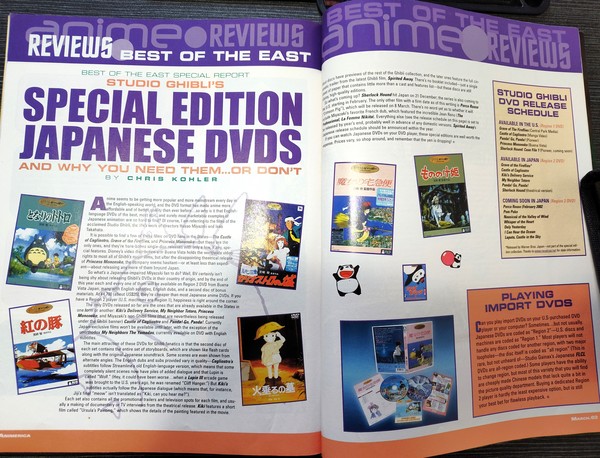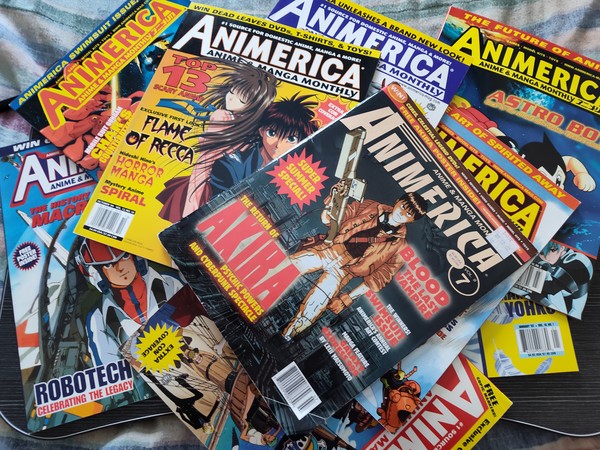I got into anime for the first time while I was a college student. When I was looking for information, I used to explore the internet and peruse the small manga department at my neighborhood bookshop. I happened to glance at a specific magazine in that store’s magazine area one day. Animerica was the name of it. I discovered as I turned the pages that I had a lot of knowledge on the newest anime series at my disposal. Eventually, I learned about the anime club at my college, and anime started to appear more frequently on TV. Still, I looked to Animerica for news and to see what other manga and anime series piqued my interest. I knew I had alternative sources when the journal collapsed in 2005, but I lost something important.

The creators of Viz Communications, which is now known as Viz Media, Satoru Fujii and Seiji Horibuchi, were the inspiration behind Animerica. At launch, Horibuchi and Trish Ledoux collaborated with Fujii as co-editors, supported financially by Shogakukan, a Japanese publisher. Since the late 1980s, Viz has enjoyed some success with manga; but, the two thought that a more reliable means of promoting manga and anime was required. To round out the magazine’s crew, Viz turned to Mark Simmons and Ledoux of the San Francisco-based fanzine Animag.
During the planning stages, the staff struggled to decide which direction to take the magazine: reaching out to an established anime fandom, which would have been safer but would have limited circulation once fan saturation was reached, or taking a chance to reach a market more in line with the staff’s experience as anime fans, where one wouldn’t have to be an expert to enjoy domestic releases.
The staff ultimately opted for the latter, creating content for all anime and manga fans, regardless of their age or degree of expertise, in the newspaper. “In effect, what we wanted to create with Animerica was an anime version of Premiere or Film Threat, a magazine devoted to and written for fans of Japanese animation—all fans, and all Japanese animation—no matter what their age or gender might be,” the Animerica editors wrote in 1997’s Anime Interviews: The First Five Years of Animerica Anime & Manga Monthly (1992–1997).
November 1992 saw the release of Animerica’s limited-edition preview issue by Viz, and February 1993 saw the publication of the first complete issue. The magazine was founded “with a genuine belief in the need for cross-cultural communication, that which enriches our lives and helps people to understand each other better,” according to Horibuchi’s statement in the preview edition. Horibuchi added that the reader would be able to access information that was previously only available to a select few because of the magazine’s role as a bridge connecting Japan and America.
Regretfully, at the time, not much anime was released nationally. The writing team started covering titles that were not yet officially available in North America when the first regular issue was published in February 1993. One such title was the feature that month on Mobile Suit Gundam 0083: Stardust Memory, which was not officially released in North America until 1999 on VHS and not until 2002 on TV and DVD.
Animerica was able to feature properties owned by Japanese publishers Shueisha and Shogakukan, such as Ranma ½, because of their relationships. A few employees of the magazine translated and edited manga for Viz, among them Ledoux, who penned insert features in a Ranma ½ piece detailing the process by which the team translated the opening theme. Along with promoting the magazine near the end of the tape, Viz was also releasing Ranma ½ and other anime on VHS.
News on impending releases from Japan and the U.S. was featured in an ordinary magazine issue. Some early issues included descriptions of the Japanese magazines that were published that month, including Animage and Newtype. For both Japanese and North American anime releases (on VHS, Laser Disc, and subsequently DVD), there were monthly rankings and street dates. The Japanese release dates and rankings were phased out by the magazine at the end of the 1990s and the beginning of the 2000s. The American release dates and rankings were all that remained. The magazine featured quick pieces detailing noteworthy developments and other information, along with pictures of cosplayers from recent anime festivals. According to one issue, the now-famous conference Anime Expo saw 1200 attendees, a record-breaking turnout for 1997.
Reviews of anime and eventually manga released domestically fell under the Best of the West section. Only Japanese-only anime and manga titles were covered by Best of the East. In addition, the journal reviewed video games on both domestic and foreign systems, spanning from the PC Engine to the PlayStation 2 and all platforms in between. Reviews of music began with the soundtracks to different video games and anime, and toward the conclusion of the magazine, they also included albums by Japanese music groups.
The journal contained a number of columns. “From the Forest,” authored by anime journalist Takashi Oshiguchi, served as Animerica’s debut release. When he worked as the manga shop manager at Manga no Mori (“Comics Forest”), he would talk about a variety of topics, including the manga or anime he was currently reading. Among the early issues was “Hud’s View,” authored by comic book writer James D. Hunall, who provided an insider’s perspective on the anime and manga industry during that period.
Fans of manga and anime may look to Animerica for content related to other facets of Japanese culture and otaku that they learned about as they become more involved in their interest. In response to these newfound hobbies, the staff introduced articles, like Mark Simmons’s on model building and his reviews of model kits, the majority of which were gunpla. In his “Tokyoscope” column, Patrick Macias—who is currently an editor at Otaku USA—discussed tokusatsu as well as other Japanese live-action movies and TV series. The journal featured pieces on aspects of cosplay throughout its last years. Regular dispatches providing an on-the-ground description of daily life in Japan were contributed by a number of individuals who had lived there for a while.
Every issue of Animerica had a fan art theme, ranging from “pirates” to “ninja,” in which artists drew their favorite characters as these ideas (the most common theme, inevitably, is “swimsuits”). In the letters section, people frequently shared their opinions on past issues’ articles and asked for further details or to get in touch with other readers.
Little details like the reviewers’ illustrations or brief notes at the bottom of the masthead—typically a quote from an anime featured in the issue or the music that some staff members had been listening to lately—were other details that added character to an issue. One even ran a late 1990s feature titled “Fun with Porken Beans,” which featured short comedic segments about drawing Misato from Evangelion (complete with beer can in hand) or guiding Sailor Moon through a maze to avoid obstacles like Queen Beryl and a McRib Extra Value Meal.
The magazine’s in-depth interviews with numerous anime and manga artists and English dub actors were one of its distinguishing characteristics and one of its biggest accomplishments in fandom history. It wouldn’t do the variety of interviews justice to provide a partial selection of creators and artists. To sum up, Animerica spoke with a number of the greats of the business who rose to prominence between 1975 and 2000 (some of them more than once). These early interviews were gathered and published by Viz in Anime Interviews: The First Five Years of Animerica, Anime & Manga Monthly (1992-97).
Animerica featured its fair share of advertising, just like any other magazine. There were, of course, advertisements for video games and forthcoming anime conventions, as well as advertisements from the various anime distributors seeking to promote their newest acquisitions (which, curiously, occasionally included commercials for hentai titles). Ads for a variety of hobby stores appeared at the same time, offering anything from model kits and posters to anime on video tape with order forms. Email addresses and websites replaced order forms and toll-free phone numbers. The advertisements for these companies vanished over time, and Animerica didn’t really take their place. By the last issues, only advertisements for the top wholesalers and retailers were still there.
One other noteworthy feature is that the magazine included one or two serialized manga series in its pages from its founding until about 2002. Because most manga were first released as single or double comic books in the 1990s and early 2000s, the staff planned these serializations as a way to introduce short stories and more unusual manga titles that they thought wouldn’t work well as stand-alone comic books. Works by Rumiko Takahashi, such as Urusei Yatsura, Mermaid Forest, and One-Pound Gospel, were among the titles. The magazine featured illustrations by Kaoru Shintai titled Area 88, Tony Takezaki’s AD Police, Hayao Miyazaki’s manga short Porco Rosso prior to its film adaptation, and Leji Matsumoto’s Galaxy Express 999.
In 1998, Viz produced Animerica Extra, a sibling publication, in addition to this feature in the main magazine. Described as “the anime fan’s comic magazine,” it featured multiple titles in serialized chapters for each issue, following the structure of Japanese manga magazines where they were first published. Although the titles offered were varied, they tended to concentrate on shojo, which would eventually become the magazine’s main focus as its run came to a close. The titles include Video Girl Ai by Masakazu Katsura, Kia Asamiya’s Steam Detectives, Yuu Watase’s Fushigi Yûgi, Rumiko Takahashi’s Maison Ikkoku, and Chiho Saitō’s take on Revolutionary Girl Utena. At the end of 2004, the magazine collapsed, and Viz took its place with Shojo Beat. In 2009, Shojo Beat would cease to exist.
Gundam Official Guide and The Best of Animerica: 2003 Edition are two more publications that came from the magazine in addition to Anime Interviews: The First Five Years of Animerica, Anime & Manga Monthly (1992-97). Gundam Official Guide, compiled from a special edition of Animerica magazine, was released in 2002. The book serves as a comprehensive overview of the Gundam franchise, covering events from its launch in 1979 until the year 2000, as suggested by the title. It includes the several anime series, the universe and politics these stories are set in, and different products like video games and model kits. Even if it is out of date, this is still one of the better English references to the brand, especially for the earlier years. The Best of Animerica: 2003 Edition, published by Viz in March 2003, is an anthology of feature articles from the magazine published in 2001 and 2002.
The journal had reached its zenith by 2002, yet there were indications that things were about to change. TV anime was growing on a number of networks, but the booms associated with the Sailor Moon and Pokémon series had subsided. Manga and anime had become commonplace on the book and video shop shelves, but this also meant that people could learn about this Japanese culture without the need for a magazine. The internet was growing more advanced to the point where anyone could obtain information with a few keystrokes, whether it came from the official website, fan sites, or even the website you are currently reading this article on. Animerica faced competition even in print, from publications like Wizard’s Anime Insider and ADV’s Newtype USA, which debuted in 2001 and 2002, respectively. Both publications would ultimately fail and disappear by the end of the decade.
The underlying changes occurring inside the anime industry were also becoming increasingly evident. Big box stores and divisions of larger corporations replaced the little dubbing studios and mom-and-pop shops that had characterized the cottage industry. “The glory days of the anime boom were changing into something else, something driven by marketing and sales,” former editor Julie Davis once stated. In the August 2002 issue, the Editorial acknowledged these modifications, with Davis stating that the publication has to offer viewpoints and context in addition to facts. Given how little time had passed between an anime’s Japanese and Western releases, Davis also recommended that their Best of the East section be updated. The journal underwent changes throughout, but in April 2005, the staff declared that the retail edition will cease publication with the June issue.
Although Viz published the last edition of the magazine in June 2005, it didn’t mean the end for it. Animerica persisted in two very distinct ways. The first was through periodical special editions created for different conferences, such Anime Expo. The second appeared in a free, condensed, quarterly edition of the magazine that was sold at Borders and Waldenbooks bookstores. Editions specifically for Best Buy stores were also released.
Features included news, future anime and manga titles’ release dates, a cover feature, and fan art, just like in the magazine’s original edition. But with only half as many pages as the original, this new edition was devoid of many of the elements that had been included before. This edition of the magazine ran till the end of 2007 and then completely disappeared.
Together with the farewell notes scattered throughout the magazine, the final retail issue featured a series of pieces written by former contributors and columnists reflecting on their time there (a far more polite way of doing things than what Newtype USA did with their final issue). Benjamin Wright, author of “In Stercore Invenitor” and reviewer columnist, wrote one of these pieces. “Animerica has always been an academic magazine,” Wright said. This cherished newspaper has been around to inform readers about our favorite media and to shed light on the lesser-known facts about its origins and past. However, this new mass-consumption market no longer needs or desires that kind of publication. But that’s also OK.And eventually, manga and anime will become so popular that a scholarly publication will be required to set everything in perspective. to interpret everything. once more.”
My attention was drawn to those final few phrases. Writing this piece gave me the impression that I was contributing to the creation of that context. Editor-in-chief of Anime Herald and panelist on Anime Lockdown, Samantha Ferreira, noted in her panel, “That 2008 Feeling: Exploring the Era of the 2000s Anime Bubble,” that the history of anime fandom in the United States is largely oral and may be forgotten. Although textual materials are what we work with, a lot of this could change in the future. I can attempt to make sense of some of this history by tracing the history of this magazine, given the depth of this obsession.



